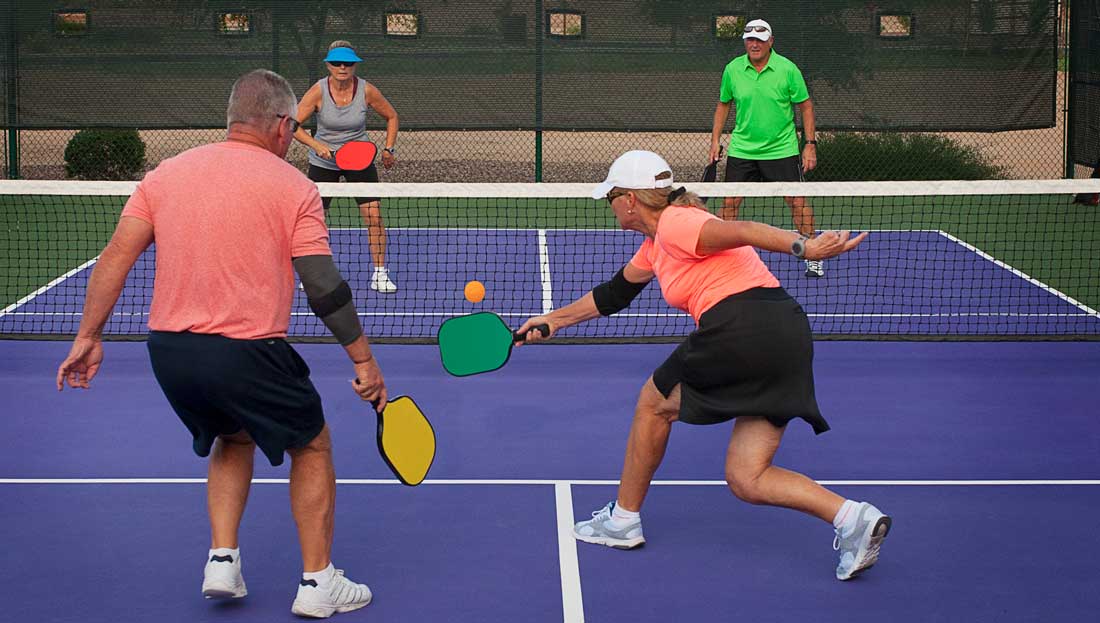
Lance C. Dalleck, Ph.D., Leslie E. Smith, M.S., and Christina A. Buchanan, Ph.D., with Daniel J. Green
Mention Pickleball and you’re likely to get one of two responses: “It’s so much fun!” or “What in the world is Pickleball?”
A quick lesson for the uninitiated: Pickleball, which originated in the 1960s as a hybrid of badminton, tennis and table tennis, can be played in either singles or doubles. Players use solid paddles made of wood or composite materials to hit a perforated polymer ball (similar to a Wiffle® ball) over a net. The beauty of the game is that the intensity and competitiveness are entirely up to the players, which means it’s simple enough for beginners or older adults, but can be fast-paced enough for more fit or skilled participants.
As the participants in this study can attest, Pickleball is a lot of fun, and the importance of that “fun factor” should not be underestimated when it comes to regular participation in physical activity. That said, there is little research available on the body’s physiological responses to Pickleball.
Understanding the cardiovascular and metabolic responses to exercise is essential for designing safe and effective physical-activity programs. Working at too low of an intensity means that many of the potential benefits of activity may go unrealized. Worse yet, exercise that is too easy can sometimes lead to boredom and eventual dropout. On the other hand, if a less-fit individual participates in a workout or activity that is too high-intensity, injury, fatigue and, again, dropout become more likely.
The key is to find that sweet spot—a safe and effective workout that yields long-term benefits and encourages lifelong participation. Is it possible that Pickleball might the answer that so many middle-aged and older adults are seeking?
To find out, ACE enlisted the help of Lance Dalleck, Ph.D., and his team of researchers in the High Altitude Exercise Physiology Program at Western State Colorado University. The purpose of their study was to quantify the acute cardiovascular and metabolic responses to Pickleball, and to determine the effectiveness of a six-week Pickleball intervention at positively modifying cardiometabolic risk factors.
The Study
The research team recruited 15 middle-aged to older men and women (40 to 85 years of age) (Table 1).
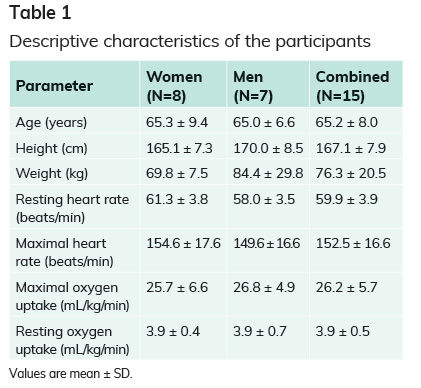
To quantify the acute cardiovascular and metabolic responses to Pickleball, participants wore a portable calorimetric measurement system as well as a heart-rate monitor. The participants played four 15-minute matches (60 minutes of physical activity) three days each week.
Prior to the onset of the study, all participants performed a graded exercise test on a treadmill to determine maximal heart rate (MHR) and maximal oxygen consumption (VO2max). In addition, the following measurements were recorded at baseline: resting heart rate, body composition, fasting blood lipids, fasting blood glucose, waist circumference and weight. These same measurements were obtained again after the six-week program in an effort to determine the effectiveness of Pickleball at positively modifying cardiometabolic risk factors.
The Results
The acute cardiovascular and metabolic responses to Pickleball are presented in Table 2, while Figure 1 illustrates the exercise intensity in terms of heart-rate reserve (HRR) for a representative participant throughout a 15-minute Pickleball bout.


Figure 1 – Exercise intensity in terms of heart rate reserve (HRR) for a representative participant throughout the duration of a Pickleball match. The dashed lines (---------) represent the moderate exercise intensity classification.
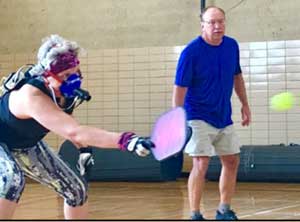 As you can see in Figure 1, the average participant reached the moderate-intensity threshold within about one minute of the onset of exercise, and intensity occasionally reached into the vigorous-intensity range. It’s important to remember, however, that there was considerable variability in terms of intensity. For example, the heart rates of the participants ranged from 79 to 158 beats per minute (see Table 2), which illustrates that the intensity of a Pickleball match is really up to the participants.
As you can see in Figure 1, the average participant reached the moderate-intensity threshold within about one minute of the onset of exercise, and intensity occasionally reached into the vigorous-intensity range. It’s important to remember, however, that there was considerable variability in terms of intensity. For example, the heart rates of the participants ranged from 79 to 158 beats per minute (see Table 2), which illustrates that the intensity of a Pickleball match is really up to the participants.
That variability is fine, as long as it’s in line with a person’s expectations and the intentions of the exercise program. Dr. Dalleck points out that it’s up to the health coach or exercise professional to ensure that anyone participating in any activity is aware of the potential risks and that the activity is not contraindicated for that individual. The last thing you want is a high-risk client exercising at an intensity that is higher than that for which you planned. For example, if an exercise program calls for low- to moderate-intensity exercise, it’s important to be aware that Pickleball sometimes moves into the vigorous territory for more competitive players, and to warn participants about the risks of overexertion.
The chronic cardiovascular and metabolic responses to Pickleball are presented in Table 3. After six weeks, participants saw favorable changes in high-density lipoprotein (HDL) and low-density lipoprotein (LDL) cholesterol, systolic and diastolic blood pressure, and VO2max. Together, these equate to a positive effect on cardiometabolic health.
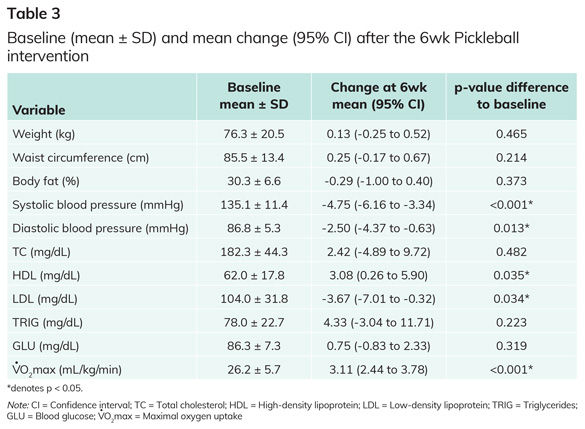
The Bottom Line
The primary finding of this study is that regular participation in Pickleball elicits cardiovascular and metabolic responses that meet exercise intensity guidelines for improving and maintaining cardiorespiratory fitness, with the average caloric expenditure equaling approximately 350 calories per 60 minutes of participation. Collectively, these findings support Pickleball as an ideal form of physical activity for middle-aged and older adults.
As all health and exercise professionals know, the importance of regular physical activity cannot be overstated, particularly for middle-aged and older adults. Decreased cardiorespiratory fitness contributes to reduced functional capacity and can eventually result in a loss of independence. In fact, low cardiorespiratory fitness may contribute to premature mortality for members of the population evaluated in this study.
For these reasons, having clients add Pickleball to their exercise routines is a great idea. Combine the findings of this research with the participants’ enjoyment of the game and you really do have an ideal form of physical activity. It’s important to highlight that the research team observed a lot of socializing, conversation and laughter before, during and after the Pickleball matches. As Dr. Dalleck reminds us, “This type of social support is tremendously valuable when it comes to long-term adherence.”
A Note about Safety
Through conversation with the study participants, the research team learned that nearly every one of them had fallen once or twice while playing Pickleball in the past. Falls are apparently very common during the game, especially for middle-aged and older adults who may lack the agility and balance required to backpedal to return a ball hit over their heads.
If you are working with newcomers to Pickleball, it’s essential that you teach them proper technique—to turn and run for the ball rather than backpedaling. All types of physical activity carry some inherent injury or fall risks, and it’s your responsibility to make all exercise experiences as safe as possible. Take some time to learn about the game and potential causes of injury before introducing Pickleball to your clients.





 by
by 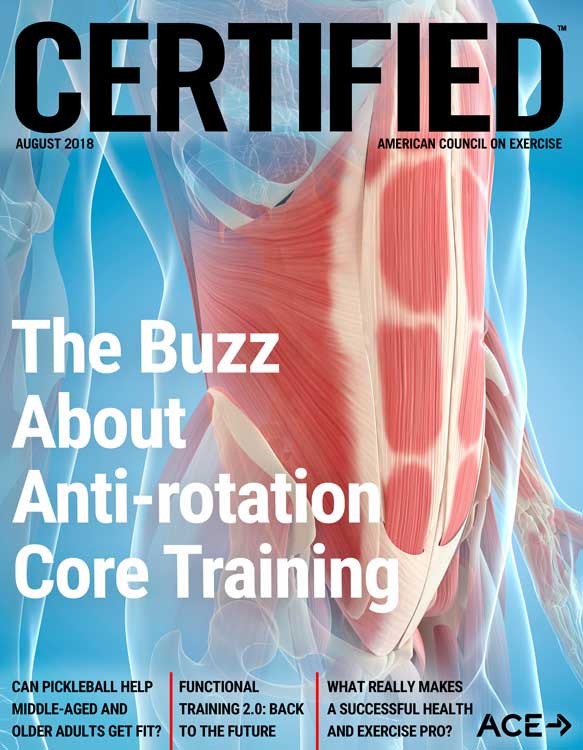

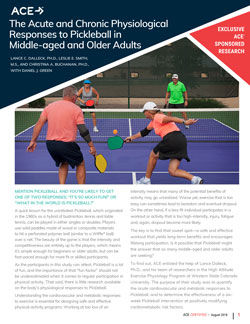



 As you can see in Figure 1,
As you can see in Figure 1, 

